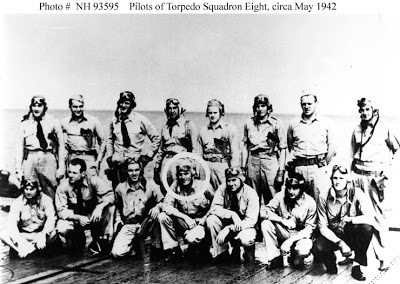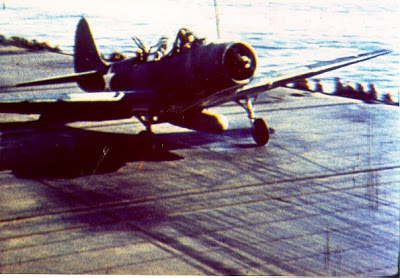 Torpedo Squadron 8, May 1942
Torpedo Squadron 8, May 1942Torpedo Squadron 8 (VT-8) was a United States Navy squadron of torpedo bombers assigned to the Air Group operating from the aircraft carrier USS Hornet (CV-8). The squadron joined the ship shortly after its commissioning in October 1941 and remained in the Pacific following her sinking in the Battle of the Santa Cruz Islands in October 1942.
VT-8's first and best-known combat mission came during the Battle of Midway on 4 June 1942. Flying the vulnerable Douglas TBD Devastators, Commander John C. Waldron's 15 planes were all shot down during their unescorted torpedo attack on four Japanese aircraft carriers. The squadron did not destroy any enemy aircraft with their rear .30-caliber machine guns, nor did they damage any of the Japanese carriers.
All members of Torpedo Squadron 8 who flew from the Hornet on that day perished in the action, with the exception of Ensign George Gay. Torpedo 8 was afterwards awarded the American Presidential Unit Citation. -- Wikipedia.
The American attack on the Japanese carriers was uncoordinated and poorly executed. Commander Waldron's squadron arrived without its fighter escort. Waldron realized it was a suicide mission, but he ordered his flyers to attack anyway, saying, "We will go in. We won't turn back. We will attack. Good luck."
All 15 of his planes were shot down with only one pilot, Ensign George Gay, left floating on the Pacific with a box seat to the most crucial naval battle of the Second World War.
The torpedo planes from the Yorktown, VT-3, and the Enterprise, VT-6, fared little better. In all, of the 41 torpedo planes which sortied against the Japanese that day, only six survived.
However, the act of drawing down to the deck the Japanese Zero fighters during the doomed attack from their top cover position allowed a subsequent wave of American dive bombers to arrive over the enemy carriers unopposed. Death came to the Japanese from on high, but it was the torpedo squadrons' sacrifice that made American victory possible.
It was, as Gordon Prange called it, the "Miracle at Midway."
 Douglas Devastator torpedo bomber, by 1942 it was hopelessly slow and vulnerable to enemy fire.
Douglas Devastator torpedo bomber, by 1942 it was hopelessly slow and vulnerable to enemy fire.If so, it was a miracle bought with the blood and sacrifice of Torpedo Squadron Three, Six and Eight. Remember them this day, the sixty-seventh anniversary of the battle.
The Men of Torpedo Squadron Eight Killed at Midway.
Lt. Commander John C. Waldron
Lt. Raymond A. Moore
Lt. James C. Owens, Jr.
Lt.(jg) George M. Campbell
Lt.(jg) John P. Gray
Lt.(jg) Jeff D. Woodson
Ens. William W. Abercrombie
Ens. William W. Creamer
Ens. Harold J. Ellison
Ens. William R. Evans
Ens. Henry R. Kenyon
Ens. Ulvert M. Moore
Ens. Grant W. Teats
Robert B. Miles, Aviation Pilot 1c
Horace F. Dobbs, Chief Radioman
Amelio Maffei, Radioman 1
Tom H. Pettry, Radioman 1
Otway D. Creasy, Jr. Radioman 2
Ross H. Bibb, Jr., Radioman 2
Darwin L. Clark, Radioman 2
Ronald J. Fisher, Radioman 2
Hollis Martin, Radioman 2
Bernerd P. Phelps Radioman 2
Aswell L. Picou, Seaman 2
Francis S. Polston, Seaman 2
Max A. Calkins, Radioman 3
George A. Field, Radioman 3
Robert K. Huntington, Radioman 3
William F. Sawhill, Radioman 3
3 comments:
"Lest we forget..."
Wretched Dog
I've always thought that this story was inspiring. Those torpedo bomber pilots had no idea that there sacrifice would do any good. And they went in anyway, using obsolete planes armed with the worst torpedos fielded during that war.
They had a job to do. The odds were stacked against them, but they had to do what they could. They attacked and even though they died, they brought about an inprobable victory by their sacrifice.
They willingly laid down their lives to defend the Constitution they swore to defend.
Semper Fi
Molan Labe
III%
Post a Comment